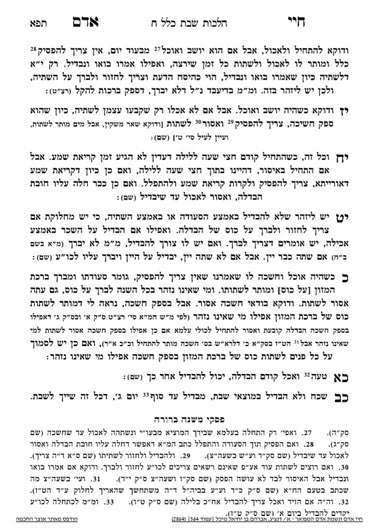We have finished siman 20, and are discussing drinking from the kos of birchas hamazon at a sheva brachos which takes place at seudah shlishis and extends past tzais. We learned that, according to Rav Moshe, the person leading birchas hamazon should not drink, but rather only the chosson and kallah should drink. Rav Moshe does not discuss whether they should only drink the kos of sheva brachos, or whether they can drink the kos of birchas hamazon as well.
The Magen Avraham’s formula, which is followed by the Chayei Adam and Mishnah Berurah as well, is that one can only drink from the kos of birchas hamazon (not in the situation of sheva brachos) if they have a chiyuv to recite birchas hamazon over a kos. The kos, in turn, becomes part of the meal. Conversely, if one does not regularly recite birchas hamazon on a kos, they hold it is not a chiyuv and therefore not part of the meal, so they would not be allowed to drink from the kos after tzais.
The sefer Tosfos Shabbos disagrees with the Magen Avraham. He writes that everyone agrees there is a mitzvah to recite birchas hamazon on a kos, even if there is no chiyuv, so everyone agrees it is muttar to drink from the kos even if it is after tzais. The issue is when one is drinking for personal benefit; here, one is drinking for a mitzvah.
Rav Ovadia Yosef suggests that between the Tosfos Shabbos and the Magen Avraham, since everyone recites sheva brachos on a kos, everyone follows the opinion that one must have a kos for birchas hamazon in our situation, so even the Magen Avraham would agree the kos becomes part of the meal. Even if the Magen Avraham would not agree, one can rely on the Tosfos Shabbos. Thus, either way, we conclude that one can drink from the kos of birchas hamazon at a sheva brachos which extends past tzais.
While on the topic of the kos of birchas hamazon, we need to clarify a few points. The person who leads birchas hamazon has no chiyuv to drink from the second kos, the kos of sheva brachos. In general, we try to minimize hefsek, so immediately after he recites hagafen, he should drink from his kos. Sure enough, the Machzor Vitri, which is the source for mixing the two kosos, actually writes that first the person who recites hagafen should drink from his kos. After he has drunk, the wine is pagum, and it should be mixed with the kos from sheva brachos to remove the pagum status. Thus, he seems to be saying that the purpose of mixing the two kosos together is to alleviate the issue of pagum from the person who recited hagafen and drank from it. Although the Machzor Vitri does not explain his reasoning, and just says to mix the kosos, this appears to be the explanation for his directive.
Thus, nowadays, where the person who recites hagafen does not drink directly from the kos, it would appear unnecessary to mix the kosos. If he does not want it to be pagum, he can pour out some wine from the chosson and kallah before drinking, but certainly does not have to mix the wine from the kos of sheva brachos into the kos of hagafen before drinking. That being said, since the Machzor Vitri is not explicit in that regard, the minhag is to mix when giving to the chassan and kallah. But there is no need for the one leading bentching to mix for himself before drinking.
Interestingly enough, people are makpid to have a kos for sheva brachos more so than birchas hamazon. However, there are many more sources regarding the chiyuv of a kos for birchas hamazon rather than sheva brachos. Ironically, most people cannot fathom sheva brachos without a kos, although many rishonim write it is unnecessary. On the other hand, many people do not recite birchas hamazon with a kos, even though the Rosh holds one must do so.
Summary
- If seudah shlishis sheva brachos finish during bain hashmashos, or even after tzais, the chosson, kallah, and mevareich can drink from the kosos.
- Regarding drinking from the kosos in general, there is no need to mix the kosos for the person leading bentching.
- Therefore, the person reciting hagafen should minimize hefsek by pouring off some of the wine into another cup and immediately drinking, rather than waiting to mix his wine with wine from the kos of sheva brachos.



